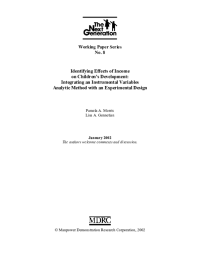Identifying Effects of Income on Children's Development
Integrating and Instrumental Variables Analytic Method with an Experimental Design
Summary of Key Findings from Working Paper No. 8
Background
An important component of welfare reform, child care subsidies help former welfare recipients secure care for their children while they are working. But recent research suggests that the intended beneficiaries of the subsidies make little or only episodic use of them. What accounts for this low level of child care subsidy use? Is it a function of widely recognized inadequacies in levels of funding or of the programs’ bureaucratic complexity? Do features of the everyday lives of low-income families also matter?
Presenting ethnographic evidence on the child care choices of 38 low-income families who were participants of in the Milwaukee New Hope experiment, this paper accounts for low and episodic patterns of child care benefit use among targeted families and offers suggestions for policies that might increase benefit use.
Key Findings
- Tying child care supplements to monthly work requirements or income thresholds might not succeed because low-wage work is often episodic and subject to change — realities that rigid program rules often do not take into account. As a result, many low-income working families who use these supports must contend with the loss or reduction of benefits as changes in family work and income situations trigger loss of benefits. Programs designed with a well-grounded understanding of how the circumstances of the families they serve vary and can change over time, by contrast, will be more likely to provide more stable benefits to a larger number of families.
- Child care subsidies generally require that care providers, whether center-based on home-based, be state-certified and licensed. In Wisconsin, subsidies cannot be spent on unlicensed caregivers. Yet, many of the families in the study sample rely on relatives and friends to provide care since this arrangement fits best with their beliefs and values associated with the meaning of home as a preferred place of child care, and the meanings relating to the safety, security, and proper child training present in care settings outside of the home.
- Child care subsidy programs may undervalue the social and moral educational qualities of more home-based settings by recognizing only the academic and social stimulation provided in center-based care; this emphasis is not consistent with the beliefs of many parents who could use assistance. One solution that would provide better match of program goals and parents’ values would be to help some parents become certified child care providers. By promoting higher levels of pay for such “carework,” programs can better meet their goals of placing children in effective, licensed home care while leaving child care subsidy users feeling more comfortable knowing that their children are being cared for by people they know and whose values they share.







